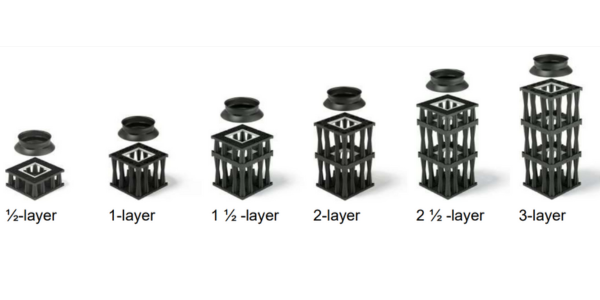frequently asked questions
FAQ - Frequently asked Questions about Stormwater Management Systems
To speak to one of our agents online about Frequently asked questions, click here
Find below the list of most Frequently asked questions regarding Stormwater Management Systems (FAQ – Questions about Stormwater Management Systems) and the Tricel range of reliable solutions.
Stormwater MaNAGEMENT questions
An attenuation system offers a lasting remedy for mitigating the risk of flooding resulting from water runoff during extended periods of rainfall. These systems incorporate a flow control chamber designed to regulate the volume of water discharged into a nearby sewer system or watercourse, such as a river or reservoir.
Historically, attenuation have been positioned beneath car parks or within access roads in high-volume residential developments.
Advantages of the proposed storm drainage system encompass minimizing disruptions and decreasing carbon footprints. Conversely, disadvantages entail higher initial investments and ongoing maintenance costs.
Unlike a soakaway system, underground floodways can be positioned much closer to a building. The critical consideration is ensuring that the building load or foundation load does not impact the tank. Ideally, if you were to draw a 45-degree angle from the foundation, that line should not intersect the system. However, this may vary depending on the depth of the tank. Nonetheless, they can be situated in proximity to the building.
To accurately size a stormwater attenuation or soakaway tank, specific information beyond volume is necessary.
Key factors include the tank’s dimensions – length, width, and height – which determine necessary components like base plates and ventilation services. Providing a drainage drawing offers a comprehensive understanding of the project, aiding in precise calculations and accurate pricing.
Additionally, knowing the tank’s location – whether under a park, driveway, or heavily trafficked area – helps design the appropriate plate system. If a drainage drawing isn’t available, providing the tank’s dimensions is crucial, though additional information may be required for detailed calculations.
To conclude
In summary, precise sizing requires detailed information on tank dimensions, location, and ideally, a drainage drawing to ensure an appropriate solution for stormwater management.
The main factors to check out to choose the best system for your project are :
- Stormwater System Application
- Sizing
- Footprint
- Cover Depth
- Base Preparation
- Stormwater System Construction Equipment
- Backfill
- Product Material
Stormwater System Total Installation Cost
Tricel Nero Range questions
The QuadroControl ST system shaft is adaptable to fit seamlessly into modular block structures measuring 0.80 meters in both length and width. It serves various purposes such as an inspection shaft or ventilation point for the system, especially when equipped with shaft covers featuring ventilation openings. The assembly comprises half elements that can be easily installed on-site, along with a cone for a full block shaft setup or a roof slab for a half block shaft configuration. The sidewall grid is included, depending on the placement within the storage or infiltration module.
Rigofill modules are conveniently delivered stacked on pallets measuring 1.60 meters by 0.80 meters. Each pallet holds 68 half elements, enough for assembling 34 modules. Typically, two pallets are stacked on top of each other when leaving the factory. Additionally, sidewall grids, supporting grids, and roof slabs (only necessary for half blocks) are packaged separately on their own pallets.
EN 17152-1 marks the inception of the inaugural product standard for storage and infiltration modules across Europe. Released in November 2019, it was accompanied by test standards for both short-term compressive strength (EN 17150) and long-term compressive strength (EN 17151).
This significant development enables the assessment and comparison of long-term compressive strength using a standardized European test methodology for the first time.
Over time, this standard is expected to supplant national approvals gradually or serve as the foundational framework for test requirements in obtaining approvals.
Rigofill storage and infiltration systems offer unparalleled flexibility in design, with minimal constraints on length and width. The square 800 mm block layout allows for seamless adaptation to virtually any configuration. With block heights of 660 mm for full blocks and 350 mm for half blocks, systems can be constructed in a myriad of sizes to accommodate single-layer or multiple-layer configurations.
This adaptability makes it easy to tailor the system to meet specific on-site requirements. In areas with high groundwater levels or low permeability soil, shallow-depth systems are preferable.
Conversely, in soils with good permeability, taller and denser systems are advantageous and can be constructed accordingly. The maximum available space is utilized to its fullest extent.
The most effective method for assessing the condition of such systems is through CCTV inspection, leveraging state-of-the-art technology. This approach enables thorough examination for final acceptance or subsequent evaluations, providing assurance and safety for authorities, engineers, construction firms, customers, and operators alike.
Rigofill modules feature a cross-shaped tunnel design, allowing for comprehensive camera accessibility and flushability in two axes, thereby enabling inspection and maintenance in four dimensions.
An underground floodway channels surplus flood or stormwater from the surface into subterranean tunnel facilities. Constructed incrementally, these flood tunnels are situated in regions where river channelization is impractical due to existing urban infrastructure.
Attenuation serves as a straightforward system for storing excess water, receiving water from various inlets like pipes and channel drains while typically having a single outlet. Acting as a void, the tank allows water to accumulate, preventing downstream drains from becoming overwhelmed during heavy storms. The outlet usually incorporates a flow control device, such as an orifice plate or vortex flow control, to regulate the discharge rate of water. Tank size is determined based on factors such as rainfall, surface area, and considerations for climate change.
Properly designed tanks should consistently accommodate the site’s water volume.
Manuals & Specifications
View and download our brochure and technical information
Contact Us
Arrange a callback or email enquiry
